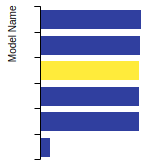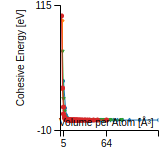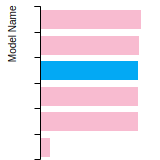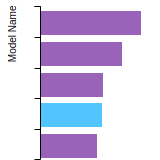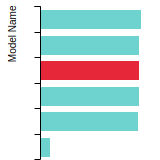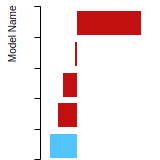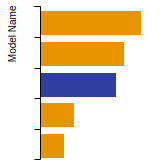 LJ_Shifted_Bernardes_1958MedCutoff_Ne__MO_160637895352_004
LJ_Shifted_Bernardes_1958MedCutoff_Ne__MO_160637895352_004
| Title
A single sentence description.
|
Lennard-Jones model (shifted) for Ne with parameters from Bernardes (1958) (medium precision cutoff) v004 |
|---|---|
| Description
A short description of the Model describing its key features including for example: type of model (pair potential, 3-body potential, EAM, etc.), modeled species (Ac, Ag, ..., Zr), intended purpose, origin, and so on.
|
Lennard-Jones (LJ) parameterization for Ne. The LJ parameters epsilon and sigma are due to Bernardes (1958). The cutoff radius is set so that phi(rcut)=tol*|phi(rmin)|, where phi(r) is the LJ potential, 'rcut' is the cutoff radius, 'rmin' is the radius at which phi(r) is a minimum, and 'tol' is a small number. Here 'tol' is taken to be 1.e-3 for a "medium-precision". See the parameter file (.params) for more details. |
| Species
The supported atomic species.
| Ne |
| Disclaimer
A statement of applicability provided by the contributor, informing users of the intended use of this KIM Item.
|
None |
| Contributor |
Ellad B. Tadmor |
| Maintainer |
Ellad B. Tadmor |
| Developer | Newton Bernades |
| Published on KIM | 2020 |
| How to Cite |
This Model originally published in [1] is archived in OpenKIM [2-5]. [1] Bernardes N. Theory of Solid Ne, A, Kr, and Xe at 0K. Physical Review. 1958;112(5):1534–9. doi:10.1103/PhysRev.112.1534 — (Primary Source) A primary source is a reference directly related to the item documenting its development, as opposed to other sources that are provided as background information. [2] Bernades N. Lennard-Jones model (shifted) for Ne with parameters from Bernardes (1958) (medium precision cutoff) v004. OpenKIM; 2020. doi:10.25950/c8a479b6 [3] Tadmor EB, Lennard-Jones J. Driver for the Lennard-Jones model uniformly shifted to have zero energy at the cutoff radius v004. OpenKIM; 2020. doi:10.25950/bdffd6a6 [4] Tadmor EB, Elliott RS, Sethna JP, Miller RE, Becker CA. The potential of atomistic simulations and the Knowledgebase of Interatomic Models. JOM. 2011;63(7):17. doi:10.1007/s11837-011-0102-6 [5] Elliott RS, Tadmor EB. Knowledgebase of Interatomic Models (KIM) Application Programming Interface (API). OpenKIM; 2011. doi:10.25950/ff8f563a Click here to download the above citation in BibTeX format. |
| Citations
This panel presents information regarding the papers that have cited the interatomic potential (IP) whose page you are on. The OpenKIM machine learning based Deep Citation framework is used to determine whether the citing article actually used the IP in computations (denoted by "USED") or only provides it as a background citation (denoted by "NOT USED"). For more details on Deep Citation and how to work with this panel, click the documentation link at the top of the panel. The word cloud to the right is generated from the abstracts of IP principle source(s) (given below in "How to Cite") and the citing articles that were determined to have used the IP in order to provide users with a quick sense of the types of physical phenomena to which this IP is applied. The bar chart shows the number of articles that cited the IP per year. Each bar is divided into green (articles that USED the IP) and blue (articles that did NOT USE the IP). Users are encouraged to correct Deep Citation errors in determination by clicking the speech icon next to a citing article and providing updated information. This will be integrated into the next Deep Citation learning cycle, which occurs on a regular basis. OpenKIM acknowledges the support of the Allen Institute for AI through the Semantic Scholar project for providing citation information and full text of articles when available, which are used to train the Deep Citation ML algorithm. |
This panel provides information on past usage of this interatomic potential (IP) powered by the OpenKIM Deep Citation framework. The word cloud indicates typical applications of the potential. The bar chart shows citations per year of this IP (bars are divided into articles that used the IP (green) and those that did not (blue)). The complete list of articles that cited this IP is provided below along with the Deep Citation determination on usage. See the Deep Citation documentation for more information. 
Help us to determine which of the papers that cite this potential actually used it to perform calculations. If you know, click the .
USED (high confidence) N. Admal and E. Tadmor, “The non-uniqueness of the atomistic stress tensor and its relationship to the generalized Beltrami representation,” Journal of The Mechanics and Physics of Solids. 2016. link Times cited: 16 USED (high confidence) H. Tani, K. Sakamoto, and N. Tagawa, “Conformation of Ultrathin PFPE Lubricants With Different Structure on Magnetic Disks—Direct Observation and MD Simulation,” IEEE Transactions on Magnetics. 2009. link Times cited: 18 Abstract: Three types of PFPE lubricants (Z-tetraol, TA-30, and D-4OH)… read more USED (high confidence) K. Ibuki and M. Ueno, “Fokker–Planck–Kramers equation treatment of dynamics of diffusion-controlled reactions using continuous velocity distribution in three dimensions,” Journal of Chemical Physics. 2003. link Times cited: 10 Abstract: A theory has been developed for the short-time dynamics of d… read more USED (high confidence) K. Ball and R. Berry, “Dynamics on statistical samples of potential energy surfaces,” Journal of Chemical Physics. 1999. link Times cited: 32 Abstract: Prior work [K. D. Ball and R. S. Berry, J. Chem. Phys. 109, … read more USED (high confidence) K. Ball and R. Berry, “Realistic master equation modeling of relaxation on complete potential energy surfaces: Partition function models and equilibrium results,” Journal of Chemical Physics. 1998. link Times cited: 30 Abstract: To elucidate the role that potential surface topography play… read more USED (low confidence) L. Liu et al., “Molecular dynamics study on the enhancement of heterogeneous nucleate boiling of mixed liquid on superhydrophilic surfaces,” Applied Thermal Engineering. 2023. link Times cited: 1 USED (low confidence) L. Liu, C. Sun, Y. Li, H. Han, J. Zhu, and Z. Su, “A molecular dynamics study on the mechanism of heterogeneous bubble nucleation of mixed liquid,” International Communications in Heat and Mass Transfer. 2022. link Times cited: 2 USED (low confidence) K. Kasahara and H. Sato, “A theory of diffusion controlled reactions in polyatomic molecule system.,” The Journal of chemical physics. 2016. link Times cited: 5 Abstract: The conventional Smoluchowski equation has been extensively … read more USED (low confidence) N. Inui, K. Mochiji, and K. Moritani, “A Nondestructive Method for Probing Mechanical Properties of a Thin Film Using Impacts with Nanoclusters,” International Journal of Applied Mechanics. 2016. link Times cited: 7 Abstract: The impact of an argon (Ar)-cluster ion on a thin film is ev… read more USED (low confidence) H. C. Hoffmann et al., “High-pressure in situ 129Xe NMR spectroscopy and computer simulations of breathing transitions in the metal-organic framework Ni2(2,6-ndc)2(dabco) (DUT-8(Ni)).,” Journal of the American Chemical Society. 2011. link Times cited: 99 Abstract: Recently, we have described the metal-organic framework Ni(2… read more USED (low confidence) R. Akiyama, Y. Karino, H. Obama, and A. Yoshifuku, “Adsorption of xenon on a protein arising from the translational motion of solvent molecules.,” Physical chemistry chemical physics : PCCP. 2010. link Times cited: 14 Abstract: A simple method was used to predict binding sites and to cal… read more USED (low confidence) V. Dolocan, A. Dolocan, and V. Dolocan, “A HAMILTONIAN FOR THE BOSON–BOSON INTERACTION BASED ON ELASTIC COUPLING THROUGH FLUX LINES,” Modern Physics Letters B. 2009. link Times cited: 1 Abstract: We present a Hamiltonian for the boson–boson interaction, ba… read more USED (low confidence) Y. Takagishi, T. Kubo, and T. Nakada, “Impurity effects on nucleation of supercooled Lennard-Jones melt: A molecular dynamics study,” Journal of Crystal Growth. 2009. link Times cited: 0 USED (low confidence) Y. Takagishi, T. Kubo, H. Hondoh, and T. Nakada, “Systematic study of solidification of Lennard-Jones melts including an impurity molecule,” Journal of Crystal Growth. 2008. link Times cited: 2 USED (low confidence) C. Cazorla and J. Boronat, “Atomic kinetic energy, momentum distribution, and structure of solid neon at zero temperature,” Physical Review B. 2008. link Times cited: 9 Abstract: We report on the calculation of the ground-state atomic kine… read more USED (low confidence) K. Ibuki and M. Ueno, “Application of Fokker-Planck-Kramers equation treatment for short-time dynamics of diffusion-controlled reaction in supercritical Lennard-Jones fluids over a wide density range.,” The Journal of chemical physics. 2006. link Times cited: 4 Abstract: The validity of a Fokker-Planck-Kramers equation (FPKE) trea… read more USED (low confidence) J. Bigeleisen, “Theoretical Basis of Isotope Effects from an Autobiographical Perspective.” 2005. link Times cited: 11 USED (low confidence) M. Przychowski, H. Wiechert, G. Marx, and G. Schönhense, “Real-space observation of xenon adsorption and desorption kinetics on graphite (0001) by photoemission electron microscopy,” Surface Science. 2003. link Times cited: 8 USED (low confidence) K. Ibuki, F. Nishiguchi, and M. Ueno, “Improved Velocity Distribution Applied to Fokker–Planck–Kramers Equation Treatment for Dynamics of Diffusion-Controlled Reactions in Two Dimensions,” Bulletin of the Chemical Society of Japan. 2003. link Times cited: 9 Abstract: The validity of theoretical treatments of short-time dynamic… read more USED (low confidence) K. Ishii, Y. Kodama, and T. Maekawa, “Microscopic dynamic analysis of heat and mass transfer,” Nonlinear Analysis-theory Methods & Applications. 1997. link Times cited: 0 USED (low confidence) C. J. Tsai and K. Jordan, “Use of the histogram and jump‐walking methods for overcoming slow barrier crossing behavior in Monte Carlo simulations: Applications to the phase transitions in the (Ar)13 and (H2O)8 clusters,” Journal of Chemical Physics. 1993. link Times cited: 116 Abstract: The histogram and jump‐walking algorithms are combined to de… read more USED (low confidence) S. Doyen-Lang, A. Charlier, L. Lang, M. Charlier, and E. Mcrae, “Theoretical study of charge transfer in graphite intercalation compounds,” Synthetic Metals. 1993. link Times cited: 6 USED (low confidence) P. Mohazzabi and F. Behroozi, “Vibrational Energy as a Function of Interatomic Distance in Rare‐Gas Solids. A Universal Relationship,” Physica Status Solidi B-basic Solid State Physics. 1988. link Times cited: 2 Abstract: A universal relationship between the reduced vibrational ene… read more USED (low confidence) S. Valkealahti and R. Nieminen, “Molecular dynamics investigation of the premelting effects of Lennard-Jones (111) surfaces,” Physica Scripta. 1987. link Times cited: 24 Abstract: Molecular dynamics simulations have been performed to study … read more USED (low confidence) B. Guillot, “Theoretical investigation of the dip in the far infrared absorption spectrum of dense rare gas mixtures,” Journal of Chemical Physics. 1987. link Times cited: 24 Abstract: The far infrared absorption spectrum of dense rare gas mixtu… read more USED (low confidence) H. Hiyagon and M. Ozima, “Partition of noble gases between olivine and basalt melt,” Geochimica et Cosmochimica Acta. 1986. link Times cited: 120 USED (low confidence) G. A. Natanson and R. Berry, “Splitting the degeneracy of harmonically-bound identical spinless bosons: Pairwise delta-function potentials,” Annals of Physics. 1984. link Times cited: 4 USED (low confidence) D. Toms and W. H. Tanttila, “Nonlinear Excitations in a Lennard-Jones Solid,” Physica Status Solidi B-basic Solid State Physics. 1980. link Times cited: 0 USED (low confidence) R. Etters and J. Kaelberer, “On the character of the melting transition in small atomic aggregates,” Journal of Chemical Physics. 1977. link Times cited: 106 Abstract: The melting transition in small clusters of N atoms is inves… read more USED (low confidence) Y. Hirai and S. Hyodo, “Mean residence time of potassium ions on tungsten as measured with reference to ionization efficiency,” Surface Science. 1977. link Times cited: 8 USED (low confidence) Ş. Kiliç and M. Ristig, “A generalized cell model for liquid helium and nuclear matter,” Il Nuovo Cimento B (1971-1996). 1977. link Times cited: 1 USED (low confidence) J. Kaelberer and R. Etters, “Phase transitions in small clusters of atoms,” Journal of Chemical Physics. 1977. link Times cited: 134 Abstract: The Monte Carlo method is used to calculate the average ther… read more USED (low confidence) P. Jewsbury, “On the interpretation of rainbow scattering in gas atom/surface collisions,” Surface Science. 1975. link Times cited: 14 USED (low confidence) R. H. Prince, “Model for Production of Hydrogen Clusters,” Nature. 1973. link Times cited: 2 USED (low confidence) D. Chaturvedi and J. Baijal, “Non-Gauss Effects in Thermal-Neutron Scattering in Liquid Argon,” Journal of the Physical Society of Japan. 1971. link Times cited: 0 USED (low confidence) K. Mahesh, “Debye Model Calculations of the Mössbauer Effect of 9.3 keV Transition of Kr 83 Solid,” Journal of the Physical Society of Japan. 1970. link Times cited: 11 Abstract: The influence of temperature and pressure on the recoilless … read more USED (low confidence) H. Glyde, “Anharmonicity and potentials for the solidified inert gases,” Journal of Physics C: Solid State Physics. 1970. link Times cited: 10 Abstract: The parameters for a representative two-body Morse potential… read more USED (low confidence) N. S. Gillis, N. Werthamer, and T. Koehler, “Properties of Crystalline Argon and Neon in the Self-Consistent Phonon Approximation,” Physical Review. 1968. link Times cited: 136 USED (low confidence) P. Roberts, “Potential energy integrals for non-overlapping atomic wave functions.” 1966. link Times cited: 1 Abstract: An analysis is presented of the potential energy integrals a… read more USED (low confidence) B. Kamb, “Overlap Interaction of Water Molecules,” Journal of Chemical Physics. 1965. link Times cited: 24 Abstract: The dense‐phase ice VII has special features that enable its… read more USED (low confidence) A. Grosse, “The compressibility of solid noble gases and the alkali metals at 0°K,” Journal of Inorganic and Nuclear Chemistry. 1964. link Times cited: 5 USED (low confidence) G. Boato, “The solidified inert gases,” Cryogenics. 1964. link Times cited: 27 USED (low confidence) F. O. Goodman, “On the theory of accommodation coefficients—III: Classical perturbation theory for the thermal accommodation of light gases,” Journal of Physics and Chemistry of Solids. 1963. link Times cited: 79 USED (low confidence) J. W. Stewart, “Compression and Phase Transitions of Solid HCl, HBr, SiH4, and SF6,” Journal of Chemical Physics. 1962. link Times cited: 18 Abstract: Isothermal PV curves for solid HCl, HBr, SiH4, and SF6 have … read more USED (low confidence) G. Boato and G. Casanova, “A self-consistent set of molecular parameters for neon, argon, krypton and xenon,” Physica D: Nonlinear Phenomena. 1961. link Times cited: 41 USED (low confidence) I. Zucker, “The Reduced Equation of State of the Inert Gas Solids at the Absolute Zero.” 1961. link Times cited: 7 Abstract: It is shown that a law of corresponding states exists amongs… read more USED (low confidence) R. I. Beecroft and C. A. Sewnson, “An experimental equation of state for sodium,” Journal of Physics and Chemistry of Solids. 1961. link Times cited: 86 USED (low confidence) J. Bigeleisen and E. Roth, “VAPOR PRESSURES OF THE NEON ISOTOPES,” Journal of Chemical Physics. 1960. link Times cited: 60 Abstract: The ratio of the vapor pressures of Ne20 and Ne22 have been … read more USED (low confidence) N. Bernardes and H. Primakoff, “Molecule Formation in the Inert Gases,” Journal of Chemical Physics. 1959. link Times cited: 39 Abstract: The Schrodinger energy eigenvalue equation for the relative … read more USED (low confidence) H. Ebert, K. Schäfer, and G. Beggerow, “Reine Stoffe in kondensierten Phasen.” 2013. link Times cited: 0 USED (low confidence) P. Misra, “Static and Transport Properties of Solids.” 2011. link Times cited: 0 USED (low confidence) K. Ibuki and M. Ueno, “Theories and Simulations of Short-Time Dynamics of Diffusion-Controlled Reactions,” The Review of High Pressure Science and Technology. 2004. link Times cited: 1 Abstract: Theories for di ff usion-controlled reaction (DCR) dynamics b… read more USED (low confidence) S. Doyen-Lang, L. Lang, A. Charlier, M. Charlier, and E. Mcrae, “Calcul des energies et transferts de charge des mercurographitures KHgC4 et RbHgC4 par une methode quantique,” Carbon. 1994. link Times cited: 0 USED (low confidence) P. Brüesch, “Interatomic Forces and Phonon Dispersion Curves.” 1982. link Times cited: 0 |
| Funding | Not available |
| Short KIM ID
The unique KIM identifier code.
| MO_160637895352_004 |
| Extended KIM ID
The long form of the KIM ID including a human readable prefix (100 characters max), two underscores, and the Short KIM ID. Extended KIM IDs can only contain alpha-numeric characters (letters and digits) and underscores and must begin with a letter.
| LJ_Shifted_Bernardes_1958MedCutoff_Ne__MO_160637895352_004 |
| DOI |
10.25950/c8a479b6 https://doi.org/10.25950/c8a479b6 https://commons.datacite.org/doi.org/10.25950/c8a479b6 |
| KIM Item Type
Specifies whether this is a Portable Model (software implementation of an interatomic model); Portable Model with parameter file (parameter file to be read in by a Model Driver); Model Driver (software implementation of an interatomic model that reads in parameters).
| Portable Model using Model Driver LJ_Shifted__MD_498634107543_004 |
| Driver | LJ_Shifted__MD_498634107543_004 |
| KIM API Version | 2.0 |
| Potential Type | lj |
| Previous Version | LJ_Shifted_Bernardes_1958MedCutoff_Ne__MO_160637895352_003 |
| Grade | Name | Category | Brief Description | Full Results | Aux File(s) |
|---|---|---|---|---|---|
| P | vc-species-supported-as-stated | mandatory | The model supports all species it claims to support; see full description. |
Results | Files |
| P | vc-periodicity-support | mandatory | Periodic boundary conditions are handled correctly; see full description. |
Results | Files |
| P | vc-permutation-symmetry | mandatory | Total energy and forces are unchanged when swapping atoms of the same species; see full description. |
Results | Files |
| A | vc-forces-numerical-derivative | consistency | Forces computed by the model agree with numerical derivatives of the energy; see full description. |
Results | Files |
| F | vc-dimer-continuity-c1 | informational | The energy versus separation relation of a pair of atoms is C1 continuous (i.e. the function and its first derivative are continuous); see full description. |
Results | Files |
| P | vc-objectivity | informational | Total energy is unchanged and forces transform correctly under rigid-body translation and rotation; see full description. |
Results | Files |
| P | vc-inversion-symmetry | informational | Total energy is unchanged and forces change sign when inverting a configuration through the origin; see full description. |
Results | Files |
| P | vc-memory-leak | informational | The model code does not have memory leaks (i.e. it releases all allocated memory at the end); see full description. |
Results | Files |
| P | vc-thread-safe | mandatory | The model returns the same energy and forces when computed in serial and when using parallel threads for a set of configurations. Note that this is not a guarantee of thread safety; see full description. |
Results | Files |
| P | vc-unit-conversion | mandatory | The model is able to correctly convert its energy and/or forces to different unit sets; see full description. |
Results | Files |
BCC Lattice Constant
This bar chart plot shows the mono-atomic body-centered cubic (bcc) lattice constant predicted by the current model (shown in the unique color) compared with the predictions for all other models in the OpenKIM Repository that support the species. The vertical bars show the average and standard deviation (one sigma) bounds for all model predictions. Graphs are generated for each species supported by the model.
Cohesive Energy Graph
This graph shows the cohesive energy versus volume-per-atom for the current mode for four mono-atomic cubic phases (body-centered cubic (bcc), face-centered cubic (fcc), simple cubic (sc), and diamond). The curve with the lowest minimum is the ground state of the crystal if stable. (The crystal structure is enforced in these calculations, so the phase may not be stable.) Graphs are generated for each species supported by the model.
Diamond Lattice Constant
This bar chart plot shows the mono-atomic face-centered diamond lattice constant predicted by the current model (shown in the unique color) compared with the predictions for all other models in the OpenKIM Repository that support the species. The vertical bars show the average and standard deviation (one sigma) bounds for all model predictions. Graphs are generated for each species supported by the model.
Dislocation Core Energies
This graph shows the dislocation core energy of a cubic crystal at zero temperature and pressure for a specific set of dislocation core cutoff radii. After obtaining the total energy of the system from conjugate gradient minimizations, non-singular, isotropic and anisotropic elasticity are applied to obtain the dislocation core energy for each of these supercells with different dipole distances. Graphs are generated for each species supported by the model.
(No matching species)FCC Elastic Constants
This bar chart plot shows the mono-atomic face-centered cubic (fcc) elastic constants predicted by the current model (shown in blue) compared with the predictions for all other models in the OpenKIM Repository that support the species. The vertical bars show the average and standard deviation (one sigma) bounds for all model predictions. Graphs are generated for each species supported by the model.
FCC Lattice Constant
This bar chart plot shows the mono-atomic face-centered cubic (fcc) lattice constant predicted by the current model (shown in red) compared with the predictions for all other models in the OpenKIM Repository that support the species. The vertical bars show the average and standard deviation (one sigma) bounds for all model predictions. Graphs are generated for each species supported by the model.
FCC Stacking Fault Energies
This bar chart plot shows the intrinsic and extrinsic stacking fault energies as well as the unstable stacking and unstable twinning energies for face-centered cubic (fcc) predicted by the current model (shown in blue) compared with the predictions for all other models in the OpenKIM Repository that support the species. The vertical bars show the average and standard deviation (one sigma) bounds for all model predictions. Graphs are generated for each species supported by the model.
FCC Surface Energies
This bar chart plot shows the mono-atomic face-centered cubic (fcc) relaxed surface energies predicted by the current model (shown in blue) compared with the predictions for all other models in the OpenKIM Repository that support the species. The vertical bars show the average and standard deviation (one sigma) bounds for all model predictions. Graphs are generated for each species supported by the model.
SC Lattice Constant
This bar chart plot shows the mono-atomic simple cubic (sc) lattice constant predicted by the current model (shown in the unique color) compared with the predictions for all other models in the OpenKIM Repository that support the species. The vertical bars show the average and standard deviation (one sigma) bounds for all model predictions. Graphs are generated for each species supported by the model.
Cubic Crystal Basic Properties Table
Species: NeCreators:
Contributor: karls
Publication Year: 2019
DOI: https://doi.org/10.25950/64cb38c5
This Test Driver uses LAMMPS to compute the cohesive energy of a given monoatomic cubic lattice (fcc, bcc, sc, or diamond) at a variety of lattice spacings. The lattice spacings range from a_min (=a_min_frac*a_0) to a_max (=a_max_frac*a_0) where a_0, a_min_frac, and a_max_frac are read from stdin (a_0 is typically approximately equal to the equilibrium lattice constant). The precise scaling and number of lattice spacings sampled between a_min and a_0 (a_0 and a_max) is specified by two additional parameters passed from stdin: N_lower and samplespacing_lower (N_upper and samplespacing_upper). Please see README.txt for further details.
| Test | Test Results | Link to Test Results page | Benchmark time
Usertime multiplied by the Whetstone Benchmark. This number can be used (approximately) to compare the performance of different models independently of the architecture on which the test was run.
Measured in Millions of Whetstone Instructions (MWI) |
|---|---|---|---|
| Cohesive energy versus lattice constant curve for bcc Ne v004 | view | 2178 | |
| Cohesive energy versus lattice constant curve for diamond Ne v004 | view | 2079 | |
| Cohesive energy versus lattice constant curve for fcc Ne v004 | view | 2109 | |
| Cohesive energy versus lattice constant curve for sc Ne v004 | view | 2209 |
Creators: Junhao Li and Ellad Tadmor
Contributor: tadmor
Publication Year: 2019
DOI: https://doi.org/10.25950/5853fb8f
Computes the cubic elastic constants for some common crystal types (fcc, bcc, sc, diamond) by calculating the hessian of the energy density with respect to strain. An estimate of the error associated with the numerical differentiation performed is reported.
| Test | Test Results | Link to Test Results page | Benchmark time
Usertime multiplied by the Whetstone Benchmark. This number can be used (approximately) to compare the performance of different models independently of the architecture on which the test was run.
Measured in Millions of Whetstone Instructions (MWI) |
|---|---|---|---|
| Elastic constants for bcc Ne at zero temperature v006 | view | 6266 | |
| Elastic constants for diamond Ne at zero temperature v001 | view | 9718 | |
| Elastic constants for fcc Ne at zero temperature v006 | view | 10549 | |
| Elastic constants for sc Ne at zero temperature v006 | view | 35387 |
Creators:
Contributor: ilia
Publication Year: 2024
DOI: https://doi.org/10.25950/2f2c4ad3
Computes the equilibrium crystal structure and energy for an arbitrary crystal at zero temperature and applied stress by performing symmetry-constrained relaxation. The crystal structure is specified using the AFLOW prototype designation. Multiple sets of free parameters corresponding to the crystal prototype may be specified as initial guesses for structure optimization. No guarantee is made regarding the stability of computed equilibria, nor that any are the ground state.
| Test | Test Results | Link to Test Results page | Benchmark time
Usertime multiplied by the Whetstone Benchmark. This number can be used (approximately) to compare the performance of different models independently of the architecture on which the test was run.
Measured in Millions of Whetstone Instructions (MWI) |
|---|---|---|---|
| Equilibrium crystal structure and energy for Ne in AFLOW crystal prototype A_cF4_225_a v002 | view | 90897 |
Creators: Daniel S. Karls and Junhao Li
Contributor: karls
Publication Year: 2019
DOI: https://doi.org/10.25950/2765e3bf
Equilibrium lattice constant and cohesive energy of a cubic lattice at zero temperature and pressure.
| Test | Test Results | Link to Test Results page | Benchmark time
Usertime multiplied by the Whetstone Benchmark. This number can be used (approximately) to compare the performance of different models independently of the architecture on which the test was run.
Measured in Millions of Whetstone Instructions (MWI) |
|---|---|---|---|
| Equilibrium zero-temperature lattice constant for bcc Ne v007 | view | 3836 | |
| Equilibrium zero-temperature lattice constant for diamond Ne v007 | view | 4763 | |
| Equilibrium zero-temperature lattice constant for fcc Ne v007 | view | 4316 | |
| Equilibrium zero-temperature lattice constant for sc Ne v007 | view | 3452 |
Creators: Daniel S. Karls and Junhao Li
Contributor: karls
Publication Year: 2019
DOI: https://doi.org/10.25950/c339ca32
Calculates lattice constant of hexagonal bulk structures at zero temperature and pressure by using simplex minimization to minimize the potential energy.
| Test | Test Results | Link to Test Results page | Benchmark time
Usertime multiplied by the Whetstone Benchmark. This number can be used (approximately) to compare the performance of different models independently of the architecture on which the test was run.
Measured in Millions of Whetstone Instructions (MWI) |
|---|---|---|---|
| Equilibrium lattice constants for hcp Ne v005 | view | 306276 |
Creators: Matt Bierbaum
Contributor: mattbierbaum
Publication Year: 2019
DOI: https://doi.org/10.25950/64f4999b
Calculates the phonon dispersion relations for fcc lattices and records the results as curves.
| Test | Test Results | Link to Test Results page | Benchmark time
Usertime multiplied by the Whetstone Benchmark. This number can be used (approximately) to compare the performance of different models independently of the architecture on which the test was run.
Measured in Millions of Whetstone Instructions (MWI) |
|---|---|---|---|
| Phonon dispersion relations for fcc Ne v004 | view | 94910 |
Creators:
Contributor: SubrahmanyamPattamatta
Publication Year: 2019
DOI: https://doi.org/10.25950/b4cfaf9a
Intrinsic and extrinsic stacking fault energies, unstable stacking fault energy, unstable twinning energy, stacking fault energy as a function of fractional displacement, and gamma surface for a monoatomic FCC lattice at zero temperature and pressure.
| Test | Test Results | Link to Test Results page | Benchmark time
Usertime multiplied by the Whetstone Benchmark. This number can be used (approximately) to compare the performance of different models independently of the architecture on which the test was run.
Measured in Millions of Whetstone Instructions (MWI) |
|---|---|---|---|
| Stacking and twinning fault energies for fcc Ne v002 | view | 22942268 |
Creators: Matt Bierbaum
Contributor: mattbierbaum
Publication Year: 2019
DOI: https://doi.org/10.25950/6c43a4e6
Calculates the surface energy of several high symmetry surfaces and produces a broken-bond model fit. In latex form, the fit equations are given by:
E_{FCC} (\vec{n}) = p_1 (4 \left( |x+y| + |x-y| + |x+z| + |x-z| + |z+y| +|z-y|\right)) + p_2 (8 \left( |x| + |y| + |z|\right)) + p_3 (2 ( |x+ 2y + z| + |x+2y-z| + |x-2y + z| + |x-2y-z| + |2x+y+z| + |2x+y-z| +|2x-y+z| +|2x-y-z| +|x+y+2z| +|x+y-2z| +|x-y+2z| +|x-y-2z| ) + c
E_{BCC} (\vec{n}) = p_1 (6 \left( | x+y+z| + |x+y-z| + |-x+y-z| + |x-y+z| \right)) + p_2 (8 \left( |x| + |y| + |z|\right)) + p_3 (4 \left( |x+y| + |x-y| + |x+z| + |x-z| + |z+y| +|z-y|\right)) +c.
In Python, these two fits take the following form:
def BrokenBondFCC(params, index):
import numpy
x, y, z = index
x = x / numpy.sqrt(x**2.+y**2.+z**2.)
y = y / numpy.sqrt(x**2.+y**2.+z**2.)
z = z / numpy.sqrt(x**2.+y**2.+z**2.)
return params[0]*4* (abs(x+y) + abs(x-y) + abs(x+z) + abs(x-z) + abs(z+y) + abs(z-y)) + params[1]*8*(abs(x) + abs(y) + abs(z)) + params[2]*(abs(x+2*y+z) + abs(x+2*y-z) +abs(x-2*y+z) +abs(x-2*y-z) + abs(2*x+y+z) +abs(2*x+y-z) +abs(2*x-y+z) +abs(2*x-y-z) + abs(x+y+2*z) +abs(x+y-2*z) +abs(x-y+2*z) +abs(x-y-2*z))+params[3]
def BrokenBondBCC(params, x, y, z):
import numpy
x, y, z = index
x = x / numpy.sqrt(x**2.+y**2.+z**2.)
y = y / numpy.sqrt(x**2.+y**2.+z**2.)
z = z / numpy.sqrt(x**2.+y**2.+z**2.)
return params[0]*6*(abs(x+y+z) + abs(x-y-z) + abs(x-y+z) + abs(x+y-z)) + params[1]*8*(abs(x) + abs(y) + abs(z)) + params[2]*4* (abs(x+y) + abs(x-y) + abs(x+z) + abs(x-z) + abs(z+y) + abs(z-y)) + params[3]
| Test | Test Results | Link to Test Results page | Benchmark time
Usertime multiplied by the Whetstone Benchmark. This number can be used (approximately) to compare the performance of different models independently of the architecture on which the test was run.
Measured in Millions of Whetstone Instructions (MWI) |
|---|---|---|---|
| Broken-bond fit of high-symmetry surface energies in fcc Ne v004 | view | 71862 |
| Test | Error Categories | Link to Error page |
|---|---|---|
| Elastic constants for hcp Ne at zero temperature v004 | other | view |
LinearThermalExpansionCoeffCubic__TD_522633393614_002
| Test | Error Categories | Link to Error page |
|---|---|---|
| Linear thermal expansion coefficient of fcc Ne at 293.15 K under a pressure of 0 MPa v002 | other | view |
No Driver
| Verification Check | Error Categories | Link to Error page |
|---|---|---|
| MemoryLeak__VC_561022993723_004 | other | view |
| PeriodicitySupport__VC_895061507745_004 | other | view |
| LJ_Shifted_Bernardes_1958MedCutoff_Ne__MO_160637895352_004.txz | Tar+XZ | Linux and OS X archive |
| LJ_Shifted_Bernardes_1958MedCutoff_Ne__MO_160637895352_004.zip | Zip | Windows archive |
This Model requires a Model Driver. Archives for the Model Driver LJ_Shifted__MD_498634107543_004 appear below.
| LJ_Shifted__MD_498634107543_004.txz | Tar+XZ | Linux and OS X archive |
| LJ_Shifted__MD_498634107543_004.zip | Zip | Windows archive |
